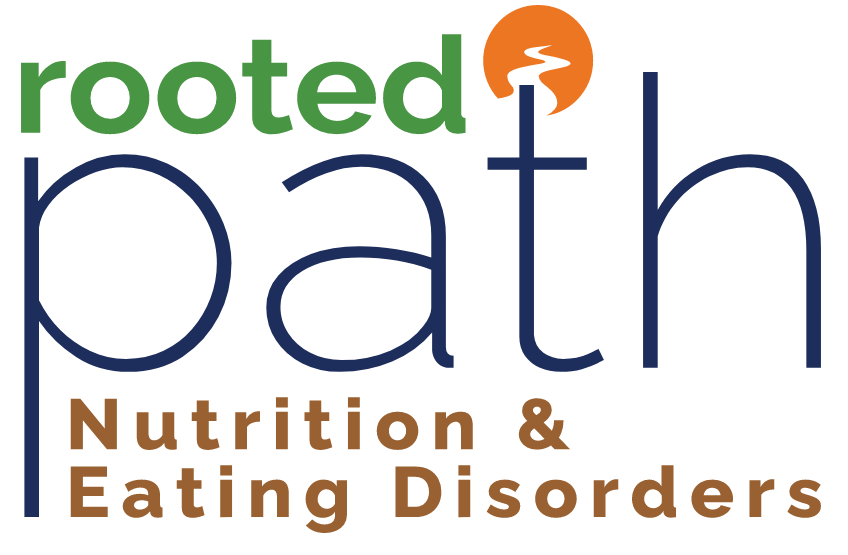At Rooted Path Nutrition, we recognize that eating disorders affect people of all backgrounds and body sizes, yet the conversation around these conditions has historically centered on white, cis-gendered, affluent experiences. As we continue to grow in our understanding of how to provide more inclusive and effective care, we want to bring awareness to the unique considerations that BIPOC (Black, Indigenous, and People of Color) individuals face when dealing with eating disorders.
This isn’t just about expanding our knowledge—it’s about acknowledging the gaps in our field and working toward more equitable care for all individuals struggling with their relationship to food and their bodies. While our own team continues to learn and grow in this area, we believe it’s important to highlight a few critical considerations.
The Hidden Reality: How Eating Disorders Present and Are Missed in BIPOC Communities
One of the most significant challenges in eating disorder treatment for BIPOC individuals is that these conditions are often overlooked entirely. Traditional diagnostic criteria and screening tools were developed based primarily on studies of white populations, leading to a fundamental misunderstanding of how eating disorders manifest across different cultural contexts.
Research consistently shows that eating disorders occur at similar rates across racial and ethnic groups, yet BIPOC individuals are significantly less likely to receive a diagnosis or treatment (Becker et al., 2003; Marques et al., 2011). This disparity stems from several factors, including the persistent stereotype that eating disorders are “white girl problems” and the different ways these conditions may present in different communities.
For example, while anorexia nervosa might be the most recognized eating disorder, some studies indicate that BIPOC individuals are more likely to experience binge eating disorder or other eating disorders that don’t fit the narrow image many healthcare providers have of what an eating disorder “looks like” (Franko et al., 2012; Pike et al., 2013). Additionally, cultural factors around body size, food scarcity, and survival may influence how disordered eating behaviors develop and are perceived within families and communities.
The intersection of racism and healthcare access creates additional barriers. BIPOC individuals may be more likely to have their eating disorder symptoms attributed to other causes, dismissed as less serious, or overlooked entirely due to biases in healthcare settings (Gordon et al., 2006; Striegel-Moore et al., 2003). They may also face longer wait times for treatment, have less access to specialized care, or encounter providers who lack cultural competency.
The Complex Role of Cultural Food Traditions and Family Dynamics
Food is never just about nutrition—it’s deeply intertwined with culture, family relationships, identity, and survival. For BIPOC individuals, this relationship with food often carries additional layers of meaning that traditional eating disorder treatment may not fully acknowledge or understand.
Many BIPOC cultures have rich food traditions that serve as expressions of love, connection to heritage, and community bonding. These traditions may include specific meal patterns, celebration foods, or family dynamics around eating that differ significantly from mainstream American food culture. When eating disorder treatment approaches food from a purely individualistic, clinical perspective, it can inadvertently ask clients to disconnect from important cultural practices and family relationships.
Historical trauma also plays a crucial role. Many BIPOC communities have experienced food insecurity, forced migration, or systematic oppression that created complex relationships with food availability and body size. For some families, encouraging children to eat or celebrating larger body sizes may be protective responses rooted in historical experiences of scarcity or discrimination.
Family dynamics around eating and body image may also differ across cultures. While some families may be more accepting of diverse body sizes, others may have specific cultural pressures around appearance that intersect with eating disorder behaviors in unique ways. Treatment approaches that don’t account for these cultural contexts may miss important family strengths or fail to address cultural-specific triggers and pressures.
The concept of individualism versus collectivism also impacts treatment. Many BIPOC cultures prioritize family and community wellbeing over individual needs, which can complicate treatment approaches that focus heavily on individual choice and autonomy around food and body image.
Weight Stigma and Diet Culture Through a Cultural Lens
Weight stigma and diet culture don’t exist in a vacuum—they intersect with racism, classism, and other forms of oppression in ways that particularly impact BIPOC individuals. Understanding these intersections is crucial for providing effective eating disorder treatment.
The thin ideal promoted by diet culture is not culturally neutral—it’s rooted in white, Western beauty standards that have been used to marginalize and pathologize other cultural expressions of beauty and health. For BIPOC individuals, pursuing thinness may involve not just changing their body, but disconnecting from cultural aesthetics and family traditions that celebrate different body types.
Additionally, BIPOC individuals face unique forms of weight stigma that are intertwined with racial stereotypes. Black women, for example, may face hypersexualization of their bodies or assumptions about their eating habits based on racist stereotypes. These experiences of intersectional stigma can complicate body image healing and require specialized understanding and treatment approaches.
The wellness and diet industries often appropriate cultural practices from BIPOC communities while simultaneously marginalizing the people from those cultures. This cultural appropriation can create additional complexity for BIPOC individuals trying to reconnect with their cultural food practices during eating disorder recovery.
Economic factors also play a role. BIPOC communities are more likely to experience food insecurity, live in food deserts, or have limited access to the types of foods often promoted in eating disorder treatment. Treatment approaches that don’t account for these structural realities may inadvertently create additional barriers to recovery.
Creating Culturally Responsive Treatment Approaches
Developing truly effective eating disorder treatment for BIPOC individuals requires us to move beyond simply adding diversity to existing treatment models. Instead, we need approaches that are fundamentally designed to honor cultural differences and address the unique challenges BIPOC individuals face.
This starts with recognizing that healing happens within cultural contexts, not apart from them. Effective treatment should help individuals reconnect with positive aspects of their cultural relationship with food while addressing problematic patterns. This might involve exploring family food traditions, understanding the cultural meaning of different foods, or finding ways to honor cultural celebrations while supporting recovery.
Addressing trauma and discrimination is also essential. Many BIPOC individuals have experienced racial trauma, discrimination in healthcare settings, or intersectional oppression that impacts their relationship with their body and food. Treatment approaches that don’t acknowledge these experiences may miss crucial aspects of healing.
Family and community involvement may look different across cultures. While some treatment approaches emphasize individual autonomy, many BIPOC cultures prioritize family and community input in health decisions. Culturally responsive treatment should find ways to honor these cultural values while still supporting individual healing.
Language and communication styles also matter. Different cultures have varying approaches to discussing mental health, body image, and family dynamics. Providers need to understand these differences and adapt their communication styles accordingly, rather than expecting clients to conform to Western therapeutic norms.
Finally, representation matters immensely. While not every provider needs to share their client’s cultural background, having diverse treatment teams and ensuring that BIPOC individuals can access providers who understand their experiences is crucial for effective care.
Our Commitment to Learning and Growth
At Rooted Path Nutrition, we recognize that understanding BIPOC considerations in eating disorder treatment is an ongoing journey, not a destination. As a team of white and white-passing clinicians, we acknowledge that our understanding comes from education, training, and listening to BIPOC voices in our field, rather than lived experience.
We’re committed to continuing our education, examining our own biases, and creating space for BIPOC clients to share their experiences and needs. This includes staying current with research on cultural considerations in eating disorder treatment, seeking consultation when working with clients whose cultural backgrounds differ from our own, and advocating for increased diversity and cultural competency in our field.
We also recognize the importance of referring to BIPOC clinicians when appropriate and working to build relationships with diverse providers who can offer culturally specific expertise. Sometimes the most supportive thing we can do is connect clients with providers who share their cultural background or have specialized training in culturally responsive care.
Moving Toward More Inclusive Care
Addressing BIPOC considerations in eating disorder treatment isn’t just about serving BIPOC individuals better—it’s about creating treatment approaches that are more effective for everyone. When we broaden our understanding of how culture, identity, and structural factors impact eating disorders, we develop more nuanced, individualized approaches that benefit all clients.
This work requires us to move beyond colorblind approaches that ignore cultural differences and toward culturally responsive care that celebrates and honors diversity. It means recognizing that effective treatment must address not just individual symptoms, but the broader cultural and structural factors that influence how people relate to food and their bodies.
As we continue to learn and grow in this area, we’re reminded that true healing happens when people feel seen, understood, and valued for all aspects of their identity. By working to understand and address BIPOC considerations in eating disorder treatment, we’re taking important steps toward creating more equitable, effective care for all individuals struggling with their relationship to food and their bodies.
The path toward more inclusive eating disorder treatment is complex and ongoing, but it’s essential work. Every person deserves access to care that honors their cultural background, addresses their unique challenges, and supports their individual journey toward healing. We’re committed to being part of this important change in our field.
References
Becker, A. E., Franko, D. L., Speck, A., & Herzog, D. B. (2003). Ethnicity and differential access to care for eating disorder symptoms. International Journal of Eating Disorders, 33(2), 205-212.
Franko, D. L., Becker, A. E., Thomas, J. J., & Herzog, D. B. (2012). Cross-ethnic differences in eating disorder symptoms and related distress. International Journal of Eating Disorders, 45(6), 798-803.
Gordon, K. H., Perez, M., & Joiner Jr, T. E. (2006). The impact of racial stereotypes on eating disorder recognition. International Journal of Eating Disorders, 39(3), 219-229.
Marques, L., Alegria, M., Becker, A. E., Chen, C. N., Fang, A., Chosak, A., & Diniz, J. B. (2011). Comparative prevalence, correlates of impairment, and service utilization for eating disorders across US ethnic groups: Implications for reducing ethnic disparities in health care access for eating disorders. International Journal of Eating Disorders, 44(5), 412-420.
Pike, K. M., Dohm, F. A., Striegel‐Moore, R. H., Wilfley, D. E., & Fairburn, C. G. (2001). A comparison of black and white women with binge eating disorder. American Journal of Psychiatry, 158(9), 1455-1460.
Striegel-Moore, R. H., Dohm, F. A., Kraemer, H. C., Taylor, C. B., Daniels, S., Crawford, P. B., & Schreiber, G. B. (2003). Eating disorders in white and black women. American Journal of Psychiatry, 160(7), 1326-1331.
The providers here at Rooted Path Nutrition and Eating Disorders are all weight and gender inclusive, non-diet and trained in the principles of Health at Every Size.
Reach out today – we’d love to support you on your health journey.

